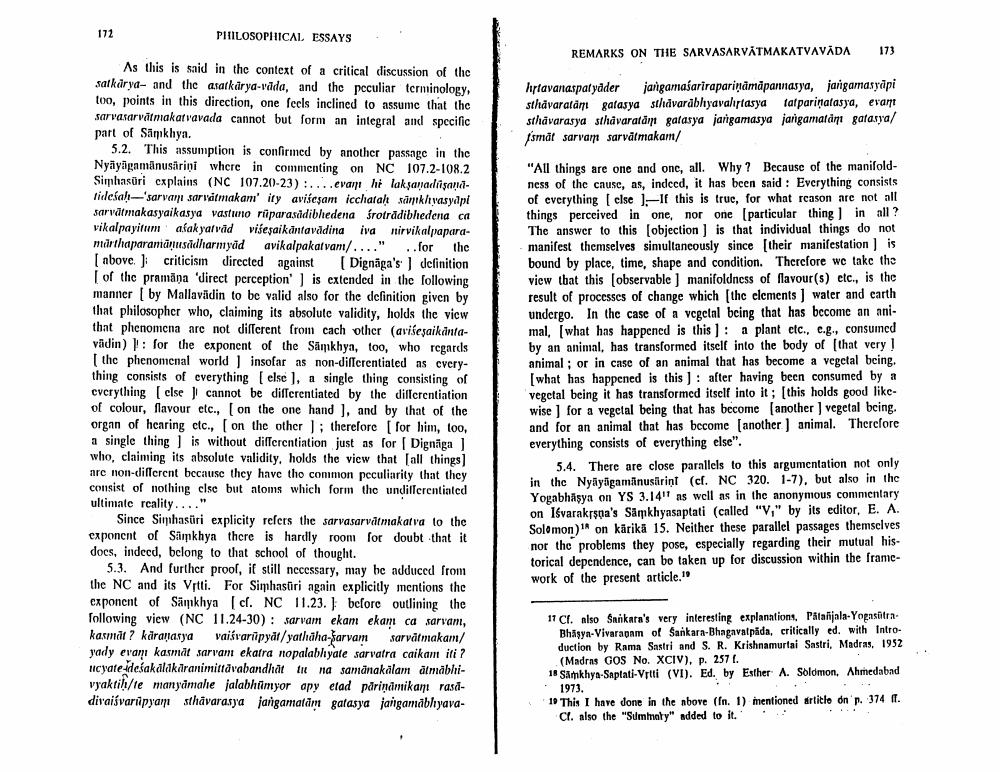Book Title: Remarks On Sarvasarvatmakatvavada Author(s): A Wezler Publisher: A Wezler View full book textPage 4
________________ 172 PHILOSOPHICAL ESSAYS REMARKS ON THE SARVASARVĀTMAKATVAVADA 173 hrfavarasparydder jargamasariraparināmāpannasya, jangamasyapi sthavaratani gatasya sthavardbhyavahistasya far parinatasya, evan sthavarasya sthavaratri gatasya jangamasya jangamatan gatasya smát sarvam sarvatmakam/ As this is said in the context of a critical discussion of the sarkarya- and the asarkdrya-vada, and the peculiar terminology too, points in this direction, one feels inclined to assume that the sarvasarvatmakarvavada cannot but form an integral and specific part of Samkhya. 5.2. This assumption is confirmed by another passage in the Nyāyāgamănusarini where in commenting on NC 107.2-108.2 Simhasüri cxplains (NC 107.20-23):....evant hi laksanadisontidesah-sarvamı sarvatmakam' ity avisesam iccharah sinkhyasyapi sarvatmakasyaikasya vastuto riparasidibhedena śrotrddibhedena ca vikalpayitum arak yalvad višesaikdntavddina iva hirvikalpapardmarthaparamánusidharmyad avikalpakafvam/. ..." .. for the (above) criticism directed against (Dignāga's ] definition of the promāņa 'direct perception is extended in the following manner [ by Mallavādin to be valid also for the definition given by that philosopher who, claiming its absolute validity, holds the view that phenomena are not different from cach other avisesaikantavadin) : for the exponent of the Samkhya, too, who regards (the phenomenal world ) insofar as non-differentiated as cverything consists of everything else), a single thing consisting of everything I clse cannot be differentiated by the differentiation of colour, flavour etc., (on the one hand ), and by that of the organ of hearing etc., on the other ; therefore [for him, too, a single thing is without differentiation just as for Dignāga ] who, claiming its absolute validity, holds the view that all things are non-different because they have the common peculiarity that they consist of nothing clse but atoms which form the undillerentiated ultimate reality...." Since Simhasüri explicity refers the sarvasarvatmakarva to the cxponent of Samkhya there is hardly room for doubt that it does, indeed, belong to that school of thought. 5.3. And further prool, if still necessary, may be adduced from the NC and its Vrtti. For Simhasüri again explicitly mentions the cxponent of Sāmkhya (cf. NC 11.23.) before outlining the Tollowing view (NC 11.24-30): sarvan ekam ekam ca sarvam, kasmat? karanasya vaisrariipyāt/yathäha-farvam sarvatmakam/ yady evam kasmát sarvam ekarra nopalabhyate sarvatra caikam ili ? licyate idešakalakaranimittāvabandhūt til na samanakalam álmäbhivyaktih/temanyamalie jalabhlimyor any elad parindmikant rasddivaišvarūpyam sthāvarasya jangamatām gatasya jangamábhyava "All things are one and one, all. Why? Because of the manifoldness of the cause, as, indeed, it has been said: Everything consists of everything else 1.- If this is true, for what reason are not all things perceived in one, nor one particular thing in all ? The answer to this (objection ) is that individual things do not manifest themselves simultaneously since their manifestation is bound by place, time, shape and condition. Therefore we take the view that this (observable) manifoldness of flavour(s) etc., is the result of processes of change which (the elements ) water and carth undergo. In the case of a vegetal being that has become an animal, (what has happened is this ] : a plant etc., e.g., consumed by an animal, has transformed itself into the body of that very ! animal; or in case of an animal that has become a vegetal being. (what has happened is this ) : after having been consumed by vegetal being it has transformed itself into it; (this holds good likewise) for a vegetal being that has become another vegetal being. and for an animal that has become (another) animal. Therefore everything consists of everything else". 5.4. There are close parallels to this argumentation not only in the Nyāyāgamánusarin (cf. NC 320.1-7), but also in the Yogabhâsya on YS 3.14" as well as in the anonymous commentary on Isvarakrspa's Samkhyasaptati (called "V," by its editor, E. A. Solomon)" on kärika 15. Neither these parallel passages themselves nor the problems they pose, especially regarding their mutual historical dependence, can be taken up for discussion within the framework of the present article." 11 C. niso Sankara's very interesting explanations, Patañjala-Yogasitra Bhagya Vivarapnm of Sankara-Bhagavatpida, critically ed. with Intro duction by Rama Sastri and S. R. Krishnamurtai Sastri. Madras, 1952 (Madras GOS No. XCIV), p. 257 1. 18 Samkhya-Saptati. Vrtti (VI). Ed. by Esther A. Solomon, Ahmedabad 1973. 10 Thin I have done in the nbove (fn. 1) mentioned article on n. 374 ff. Cl. also the "Sumhriaty" added to it.' .Page Navigation
1 2 3 4 5 6 7 8
